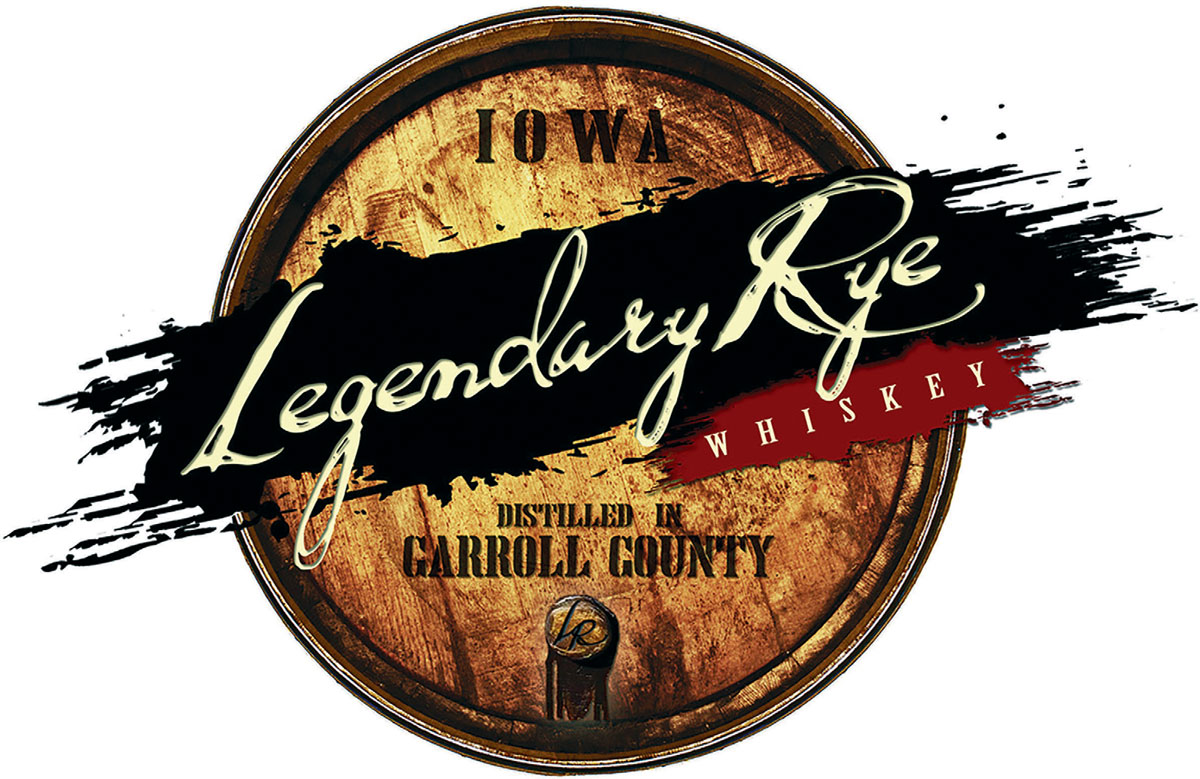How The Iowa Legendary Rye Whiskey Got Started
Distilled a Carroll County
Carroll County, Iowa, is synonymous with bootlegging. Folks around there are reluctant to give names, dates or details about the whiskey-making for which the town of Templeton and surrounding area is famous, but a name-withheld native said it was the rye whiskey made around Templeton, just south of Carroll, that got everyone through the Great Depression.
The colloquial name “Templeton rye” applied to all whiskey made in and around Templeton but, since 2006 it is used as a trademark for a whiskey bottled in Templeton.
“The Templeton rye that I knew was bootlegged,” one anonymous person said. “I remember adults talking about it: it was brewed in people’s chicken coops. They’d have false floors in their garages. They also brewed it in the basement of the Catholic Church—everybody was in on it. The way you’d get a bottle was, you’d go to your barber and say, ‘Can you get me some?’ You never mentioned what. So the barber would go to the baker, who would go to the candlestick maker, and it would go around like this until it finally got to the person who knew where it was.”
Folks say 350 barrels of hooch took the train to Chicago each day, straight to Al Capone.
Whiskeyman Rich Eggers grew up in that rich historical vein and knows the county lore firsthand. He and his wife, Lisa Chase, are about to introduce Iowa to their genuine, down-home, prohibition-era whiskey made in Carroll: Iowa Legendary Rye.
“The family that passed this recipe down to us had three 500-gallon stills going during prohibition era, and all of it went to Al Capone,” Rich said. “Forgive me, but I hate Al Capone; I don’t even want to bring up his name, I’m just telling you what the whiskey was made for. Saying that Capone had the only Templeton rye recipe is BS. It’s like going to the racetrack and saying, ‘I have the only thoroughbred here.’ It was made in Carroll County, Crawford County, but down by Templeton, they were famous because they made pure, clean whiskey that wouldn’t make you sick, wouldn’t blind you, wouldn’t kill you. They had a reputation for good whiskey.”
Rich learned about whiskey as a youth: One of his family members taught him the ropes.
“When you grow up in certain surroundings, it’s normal for you, if you’ve never been anywhere,” he said. “My dad was a lineman for 47 years, and he’d come home and he’d tell about how he had to go to farms down by Templeton when we had blizzards, and they had to let him underneath the chicken coop or the hog shed where there were stills set up. I fell in love with making it, and Lisa fell in love with it.”
A typical Carroll County adolescence included bootlegging as a part of life: basement whiskey, barn whiskey, hidden whiskey.
“When you got older, maybe somebody would say, ‘Hey, you want to load this stuff up and run over there? I’ll give you twenty bucks.’ Hell, yeah! I wasn’t selling it, but everybody knew about it and it was OK,” Rich said. “These weren’t bad people: They made whiskey to save their farms and, back in the old, old days, to feed the kids. They’d give you the shirts off their backs.” Rich’s account of local whiskey making was, necessarily, devoid of specific names.
“This family member of mine went over to see [a person]. My family had another Templeton rye recipe back in that era,” Rich said. “[That person] has been dead for years [and] was in [their] nineties back then. [That person] took the recipe this family member of mine brought over and said, ‘No, this is wrong—you do this, you do this, you do this, and that’s what I’m making.”
He said there were at least 30 Templeton-area rye whiskey recipes at one time.
“They were all good recipes, but a lot of them weren’t a hundred percent rye because that’s very hard to do. But they were all clean, and they were made by good people who weren’t gangsters that went out and killed people. They were damn good people.”
Today, stills still abound in secret corners. It’s a felony to have one without a license, but in Iowa, you have to have a still to get a license to make whiskey.
Distilling spirits at home violates federal law, but with proper permits you can brew ethanol for fuel or, like the Eggers, as a craft spirits company. The licensing process in Iowa is a cooperative effort between the applicant, local authorities and the Iowa Alcoholic Beverages Division. That’s a polite way of saying Iowa code is a confusing gauntlet.
Iowa has just one wholesaler for distilled spirits—the state. A distillery must send its products to the ABD warehouse in Ankeny, where it’s marked up 50 percent. Retailers buy from the state and add their own markup.
Small wonder folks make homebrew.
“I said, ‘Let’s make whiskey,’ and Lisa said, ‘OK, we’ll try it’ and we’re doing it,” Rich said. They got their license last year.
“Did you know rye whiskey is good for you?” Lisa said.
Indeed it is: The American Journal of Clinical Nutrition says alcohol increases total energy and decreases carbohydrate intake in men and women, helping dieters. Whiskey has high levels of ellagic acid, an antioxidant compound that helps neutralize free radicals, those cellular bandits that cause cancer and heart disease. And whiskey has been shown to reduce the chances of diabetes by as much as 30 to 40 percent.
Binge drinking, however, can increase the risk of all those bad boys.
Aged Iowa Legendary Rye whiskey isn’t yet available— they couldn’t start making whiskey until they got their license last year, so it will be some time before their first runs age. They’ll start selling clear rye whiskey in March under the name White Dog; the aged product will come next year.
White dog is slang for raw, young whiskey, or moonshine. “See, legally, if I would have had anything made, I can’t use it because it’s against the law,” Rich said of his planned aged whiskey. “I have to start now, start making it and store some of it in barrels for fifteen months and some of it in barrels for five years. In fifteen months, I’ll be able to sell some really good aged whiskey.”
The couple said White Dog is good for drinking straight, like moonshine, and for making special drinks such as fruit drinks.
“That’s what we’re going to sell to try and get some money coming back in,” Rich said.
Lisa said White Dog works well with another Legendary product: Firebomb.
“Firebomb is a spice mix that comes in a little tin,” she said. “You mix it with some White Dog, some apple concentrate, and then you’ve got your won flavoured whiskey. It also comes in apple pie flavor. And it’s gluten free!”
They’ll sell Firebomb tins at the distillery, once the public area is up and running.
“Our whiskey is one hundred percent rye whiskey,” Rich said. “We buy our rye two places: one here in Carroll County, and Jim Riesburg is supplying me with rye from Ohio. He’s working with a local farmer to bag it in 50-pound bags for me so I can get everything from Carroll County but my barrels and my bottles. The bottles come from New York, the barrels come from Minnesota: white oak, heavily charred.”
Straight rye has to be aged in new barrels to earn the moniker. Otherwise, it has to be called blended whiskey or something else, such as American whiskey.
“There are millions of rye recipes on the Internet,” Rich said. “According to some of these guys who are supposed to know everything, you can’t use just pure rye. I’m using pure rye, water, sugar and yeast. I’m not making any malt, I’m not boiling it, I’m not cooking it.”
Normally, an enzyme in malted barley contributes to the fermentation process, but Eggers side-stepped that issue.
“There’s an old-school way to do it,” was all he said. It’s a family secret.
“There’s another way to get it to work for itself, and that’s what I do,” he said. He added that, no matter the recipe, application of heat is critical.
“If you’re not patient, you may make good whiskey, but you will never make great whiskey,” he said. “From the time it hits 147 degrees and is putting out heads, it’s three and a half hours to finish. If people knew how long it takes me to heat this stuff up, they’d think I was insane and put me in the Cherokee mental institution.”
Basically, as the rye mash heats up, spirits evaporate in stages: heads (the poisonous bad stuff including methanol and acetone), hearts (the good stuff, which tastes great) and tails, which are weak and nasty. Eggers doesn’t waste anything.
“People take the leftover mash for animal feed. The methanol, the heads, goes in my gas tank,” he said. “If you ran it back through the still, you could put it in your ’57 Chevy and the feds couldn’t catch you.”
“We’ve had so much support from our families, friends and the local community,” Lisa said. “This absolutely would not be possible without them. We are so grateful.”
“The two Snyder brothers, Todd and Scott, have helped me a great deal,” Rich said. “Scott helps me distill, Todd does all the plumbing and keeps all the water running. If it wasn’t for them, if it wasn’t for Lisa, none of this would have happened.”
The Iowa Legendary Rye operation will remain in the Eggers family in years to come.
“My son, Zach, has been my right hand man, learning everything he can so he can continue our whiskey tradition after I’m gone,” Rich said.
What more could a man want out of life but to pay the bills doing something he loves?
“I’m nothing special—this was all handed to me,” Rich said. “I’m proud of it, man. It’s cool to be able to do something old school. I’m not in it to get rich or sell a story; what I’m proud of is my whiskey. I’m in it to have people try it and say, ‘This is the best damn whiskey I’ve ever had.’ It’s an honor to continue a tradition.”





